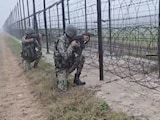Scant rainfall, snowfall and pipe leakages is blamed for the crisis. (File)
New Delhi:
The authorities in Shimla have devised a three-pronged strategy to prevent future acute drinking water shortage in the city which is presently reeling under such a crisis.
Both the Himachal Pradesh government and the Shimla Municipal Corporation (SMC) have swung into action after facing severe criticism following a major exodus of tourists from the hilly town which had a major financial impact on its revenue share.
After facing the rebuke from the Himachal Pradesh High Court, the state government deployed its Chief Secretary Vineet Chaudhary to personally supervise the situation and augment the drinking water supply to the town.
"Due to persistent efforts, we have managed to restore the drinking water supply for the past three days. We have divided 34 wards of the town into three zones and water is being now supplied alternatively to each zones," Mr Chaudhary told PTI.
He said as on today, all tanks supplying water to Shimla are full and have 37 MLDs (millions of litres per day) of water in storage.
"We have devised a three-pronged strategy -- short term, medium term and long term -- to deal with the situation in the future. The water crisis in Shimla is not something new. It has happened in the past also because there is no permanent source of water," the top official of the state, who is heading a high-level committee of officers from various departments to deal with the issue, said.
He said that a long term permanent solution would be there once over Rs 800 crore Kol Dam lift drinking water scheme comes into existence, which would supply 104 MLD of water to the capital city.
"Our DIPR is ready for the project and are awaiting sanction from the World Bank which is likely to be done by next year," Mr Chaudhary said.
He said that for the medium term in the catchment areas at the Gumma and the Giri river schemes in Shimla district the state would encourage water harvesting structures and a plan has been worked out in this regard.
"There was an issue of contamination of water in 2005 in the Ashwini Khad, which was one of the regular sources of around five MLDs of water to Shimla. Under the medium term plan, we have decided to install an Ultra Violet water treatment plant so that the water becomes consumable in Shimla," he added.
Detailing the short term plans to deal with the aggravated water crisis, Mr Chaudhary said that three wards in Shimla city will be selected under the pilot project and a new
Supervisory Control And Data Acquisition (SCADA) computerised system will be installed for round-the-clock water supply in those areas.
"Under the short term measures, we are also mapping the entire distribution network as it is a British era system so that leakages of around 3 MLDs will be plugged. An 8 km-long new pipeline will be laid to plug the three MLDs of water which is wasted into leakages," he said.
To deal with the over usage of water by hotels and restaurants in the city, Mr Chaudhary said that the SMC have been directed to rework the water metering system and a tariff plan so that the authorities are aware of who is using how much water.
On why the situation came to this level, Mr Chaudhary attributed it to scant rainfall, snowfall, pipe leakages and poor anticipation of the crisis on part of the municipal corporation.
"We have to understand that in Shimla, we have a British-era pipe line system laid for the supply of water to around 16,000 to 20,000 people. At present, there are around 2 lakh people plus there was contamination scare of water at Ashwini Khad, which was a regular source of water supply," he added.
Mr Chaudhary said that people living in the catchment areas of the Guma and Giri river water scheme were found using submersible water pumps to irrigate their lands which further depleted the water level.
"We have ordered patrolling in the catchment areas and 40 such water pumps were seized. It can't be denied that water was stored or overused by some hotels, but steps were taken to disconnect water connections of such establishments," he said.
He added that the administration even inked an agreement with the local panchayats in the catchment areas under which water for five hours was supplied to the villages, while for the rest of the 19 hours the water was used for drinking purpose for Shimla.
Mr Chaudhary said that additional steps were taken to augment water supply to the capital town like no construction activities, police patrolling in the catchment areas and lifting of two-and-half lakh litres of waters through 20 huge tankers from the Sunni area of Shimla district to the Gumma water treatment plant.
He said that the government is trying to ensure that no such situation arises in the future and all future action plan is implemented in letter and spirit.
Both the Himachal Pradesh government and the Shimla Municipal Corporation (SMC) have swung into action after facing severe criticism following a major exodus of tourists from the hilly town which had a major financial impact on its revenue share.
After facing the rebuke from the Himachal Pradesh High Court, the state government deployed its Chief Secretary Vineet Chaudhary to personally supervise the situation and augment the drinking water supply to the town.
"Due to persistent efforts, we have managed to restore the drinking water supply for the past three days. We have divided 34 wards of the town into three zones and water is being now supplied alternatively to each zones," Mr Chaudhary told PTI.
He said as on today, all tanks supplying water to Shimla are full and have 37 MLDs (millions of litres per day) of water in storage.
"We have devised a three-pronged strategy -- short term, medium term and long term -- to deal with the situation in the future. The water crisis in Shimla is not something new. It has happened in the past also because there is no permanent source of water," the top official of the state, who is heading a high-level committee of officers from various departments to deal with the issue, said.
He said that a long term permanent solution would be there once over Rs 800 crore Kol Dam lift drinking water scheme comes into existence, which would supply 104 MLD of water to the capital city.
"Our DIPR is ready for the project and are awaiting sanction from the World Bank which is likely to be done by next year," Mr Chaudhary said.
He said that for the medium term in the catchment areas at the Gumma and the Giri river schemes in Shimla district the state would encourage water harvesting structures and a plan has been worked out in this regard.
"There was an issue of contamination of water in 2005 in the Ashwini Khad, which was one of the regular sources of around five MLDs of water to Shimla. Under the medium term plan, we have decided to install an Ultra Violet water treatment plant so that the water becomes consumable in Shimla," he added.
Detailing the short term plans to deal with the aggravated water crisis, Mr Chaudhary said that three wards in Shimla city will be selected under the pilot project and a new
Supervisory Control And Data Acquisition (SCADA) computerised system will be installed for round-the-clock water supply in those areas.
"Under the short term measures, we are also mapping the entire distribution network as it is a British era system so that leakages of around 3 MLDs will be plugged. An 8 km-long new pipeline will be laid to plug the three MLDs of water which is wasted into leakages," he said.
To deal with the over usage of water by hotels and restaurants in the city, Mr Chaudhary said that the SMC have been directed to rework the water metering system and a tariff plan so that the authorities are aware of who is using how much water.
On why the situation came to this level, Mr Chaudhary attributed it to scant rainfall, snowfall, pipe leakages and poor anticipation of the crisis on part of the municipal corporation.
"We have to understand that in Shimla, we have a British-era pipe line system laid for the supply of water to around 16,000 to 20,000 people. At present, there are around 2 lakh people plus there was contamination scare of water at Ashwini Khad, which was a regular source of water supply," he added.
Mr Chaudhary said that people living in the catchment areas of the Guma and Giri river water scheme were found using submersible water pumps to irrigate their lands which further depleted the water level.
"We have ordered patrolling in the catchment areas and 40 such water pumps were seized. It can't be denied that water was stored or overused by some hotels, but steps were taken to disconnect water connections of such establishments," he said.
He added that the administration even inked an agreement with the local panchayats in the catchment areas under which water for five hours was supplied to the villages, while for the rest of the 19 hours the water was used for drinking purpose for Shimla.
Mr Chaudhary said that additional steps were taken to augment water supply to the capital town like no construction activities, police patrolling in the catchment areas and lifting of two-and-half lakh litres of waters through 20 huge tankers from the Sunni area of Shimla district to the Gumma water treatment plant.
He said that the government is trying to ensure that no such situation arises in the future and all future action plan is implemented in letter and spirit.















